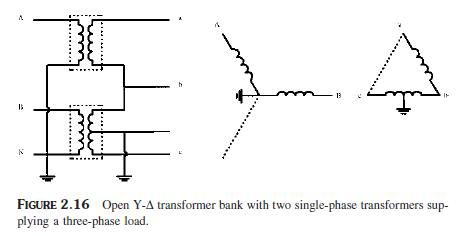What part of "only two wires" don't you understand?
Every thing you have posted confirms, what I clearly stated in my post about an open-wye primary, it takes 3 wires.
But it doesn't take 3-phase. Perhaps a play-by-play will help you understand where I was coming from:
Is this configuration still common on new installations? I know several utilities don't install it anymore. I've heard the weak leg can have issues.
The utility wants to use it for an installation I am designing - shouldn't be a problem in this case. 200-400A service.
I'm just curious as to how common this still is. I thought it was becoming extinct.
OK. The OP must be talking about an open-delta secondary service.
It is slowy becoming extinct as 3 phase is more readily available in certain areas. But, in other areas, it's still designed and implemented today, with no certain reason not to. It's an affordable way to accomplish certain things in certain areas.
As opposed to 1-phase and 2-phase primary. True enough. But to which Jim replied with the following:
An open delta configuration requires 3-phase.
What? Why would Jim dispute the fact that you don't have to have a 3-phase primary? The OP was discussing open-delta secondary so this statement is not true for the case where you have a 2-phase primary.
But was Jim considering the 2-phase primary to be a 3-phase primary? Hmmm. Jim uses the line-line voltages for a phase count and has called the wye configuration that is missing one ungrounded conductor a 1-phase configuration so he must not be including the 2-phase option.
That only leaves the conclusion that he is thinking you must have three ungrounded conductors to have an open-delta secondary. That is simply not true so maybe he forgot about the open-wye open-delta configuration. Let's see what else he posted.
An open delta primary requires three 'lines'.
That's true enough, but the OP was not discussing the primary. Hmmm, Jim might be thinking that the only way to get an open-delta secondary is to have the open-delta primary. That would not be correct so let's continue reading.
An open wye primary requires two 'lines' and a neutral.
That's true enough, but Jim said earlier that we must have a 3-phase line to get an open-delta. He does not consider an "open-wye" primary to be 3-phase as he calls that 1-phase. Since he does not think we can get an open delta without 3-phase, maybe he is thinking about an open-wye primary with an open-wye secondary that would only be used for single-phase loads (like 3-wire 120/208). Since we do not have a 3-phase primary in this case, maybe he is trying to show how the open-wye would not apply to the OP.
If the utility only has 2-wires it cannot power an open delta.
That is true for a 1-phase primary. Certainly he does not think anyone is saying you can get 3-phase from 1-phase. Perhaps he is using "wires" in place of "lines". He said earlier you must have 3-phase.
I guess I'll post this:
Sure it can (with the neutral providing the 3rd conductor or "wire"). The utility can have the primary open-wye and the secondary open-delta.
Trying to say you can have two "wires"/"lines" as long as you have a 3rd wire (commonly called the neutral), in the attempt to say that you can provide an open-delta secondary even if you have a 2-phase primary instead of a 3-phase primary.
To which Jim posted:
What part of "only two wires" don't you understand?...
Hmmm. Figures.

